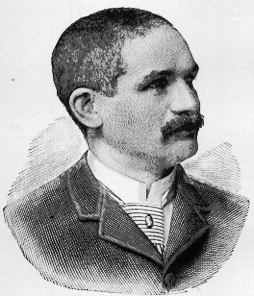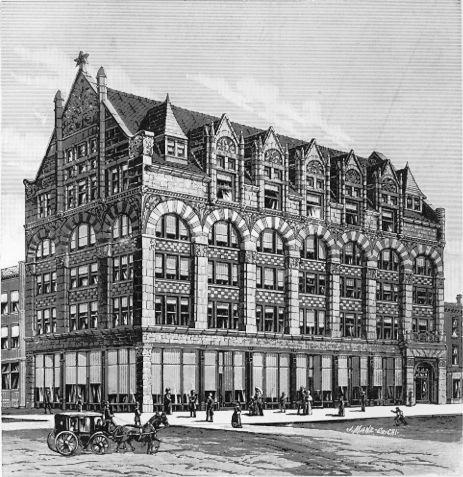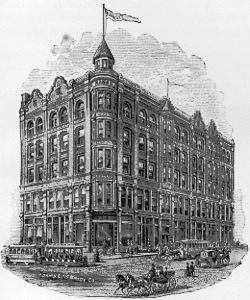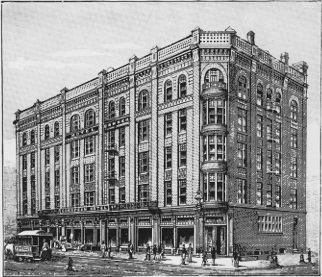|
OMAHA
ILLUSTRATED.
of twenty mills to raise the $1,600,000
annually necessary to carry on its municipal government,
while Omaha gets along with the $640,000 raised by a levy of
forty mills upon a valuation of $16,000,000. The fact that
Omaha's municipal government requires only two fifths as
much funds for its conduct as St. Paul does, is traceable
directly to superior mangement of its finances. The bonded
indebtedness of Omaha at the beginning of the fiscal
|
[Max Meyer was
born in the Kingdom of Prussia, now the chief state
in the German Empire, on August 13, 1848, and was
educated in Berlin. In 1861 he emigrated to this
country, settling in the city of New York, where he
began his business career as a clerk. In 1866 he
came to Omaha and began business on his own account
in a small way and in a small frame building on the
south side of Farnam street, near Eleventh. Three
years later he associated with him one of his
brothers, and their business having out
|
|
grown their accommodations, they removed to the
Creighton building on the north side of Farnam,
corner of Eleventh. Still their business grew until
these quarters were inadequate, when their large
double store was built on the opposite corner,
where for years has been conducted by two separate
firms (Mr. Max Meyer being the head of each),
business of a most extensive and varied character.
One store is devoted to the manufacturing and
dealing in fine jewelry and to the sale of music
and musical instruments, etc., and the other to
tobacco, cigars, guns and a great variety of other
articles, both of domestic and foreign production.
Mr. Meyer's business still keeping pace with the
growth of the city and State, he at length found
his own large building too small, and in 1886
induced Mr. Wm. A. Paxton to begin the erection of
the finest six-story block in the city on the
corner of Farnam and Sixteenth streets, 50x132
feet
|

MAX MEYER, PRESIDENT OMAHA BOARD
OF TRADE.
|
of which the Meyer brothers leased, and which by
the close of 1887 will be completed and occupied.
In this building the Meyer firms will have a
business establishment which for beauty, extent and
variety will have no equal in the West. As a
citizen and business man Mr. Max Meyer is conceded
to be one of the most active and valuable to Omaha.
There is nothing in the shape of a business
enterprise calculated to benefit Omaha that does
riot secure his attention and such aid as he can
give it. He is a charter member of the Board of
Trade, for several years a director, and in 1885
was elected its president and re-elected in 1886
and 1887. He was one of the projectors of Omaha's
splendid exposition building, and is president of
the company which erected it, He helped to organize
the Omaha Savings Bank and has been a director of
it ever since. He was prominent in securing the
erection of the fine Board of Trade building,
|
|
helped to organize the Omaha Freight Bureau, and
is always alert when the business interests of
Omaha are involved. Mr. Meyer has never sought a
political office. He belongs to the order of Odd
Fellows and has held the highest office in the
grand encampment of the State.]
|
year 1887 was $1,048,950 with no floating debt worth
mention. Bonds issued in 1869 are the oldest now
outstanding. These bear 10 per cent. interest, but the
credit of the city has since improved so much that the
$200,000 issued in 1886 (the limit of amount of bonds to be
issued in any year is fixed by the charter at $200,000) were
placed at 4 1/2 per cent.
In 1882 the bonded
indebtedness of Omaha was $328,950. During the period of
which this article treats -- 1882-87 -- the bonded debt was
increased $720,000. As previously shown, the total of public
improvements in the same period is $3,612,535 -- five times
the increase in the bonded debt. This singular result is due
to the fact that by far the larger part of the city's
improvements were paid for by surplus revenues. It should
also be explained that such improvements as paving, curbing
and guttering are paid for by the owners of abutting
property, the city bearing only the expense of street
intersections. To lighten the burden upon the property
owners, they are required to pay only one-tenth the expense
each year, the city guaranteeing the interest upon bonds
issued for ten years. About
[80]
|



